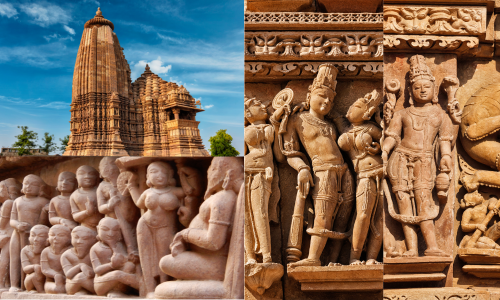Introduction
Nestled in the heart of India, the temples of Khajuraho stand as a testament to the architectural brilliance and artistic mastery of ancient India. These enigmatic temples, adorned with intricate carvings and sculptures, depict a fusion of spirituality, sensuality, and profound symbolism. In this article, we embark on a journey to uncover the secrets and beauty of Khajuraho, a UNESCO World Heritage Site that continues to captivate visitors from around the world.
History and Cultural Significance
The temples of Khajuraho were built between the 9th and 12th centuries during the Chandela dynasty. They were initially dedicated to various Hindu deities, representing a significant era in Indian history and culture. The exquisite temple art of Khajuraho is an amalgamation of religious, cultural, and artistic influences, showcasing the rich tapestry of ancient Indian civilization.
Architectural Marvels
Khajuraho temple architecture is renowned for its exceptional craftsmanship and unique structural design. The temples are primarily constructed using sandstone, and their design features intricate details and delicate carvings. The architecture reflects a perfect blend of Nagara-style and Dravidian-style elements, resulting in an awe-inspiring visual spectacle.
The Sensual Sculptures of Khajuraho
One of the intriguing aspects of Khajuraho’s artwork is the depiction of sensuality through its sculptures. These sculptures, although sensationalized, are not mere erotic art but convey deeper meanings. They symbolize the celebration of human emotions, spiritual union, and the pursuit of divine love. Khajuraho’s sensuality represents the human quest for spiritual and physical harmony.
The Temples and Their Divisions
Khajuraho’s temples are divided into three main groups: Western, Eastern, and Southern. The Western Group is the largest and most well-preserved, showcasing exquisite craftsmanship and intricate carvings. The Eastern Group features some of the earliest temples and offers a glimpse into the architectural evolution of the site. The Southern Group houses a smaller collection of temples, each with its unique charm and architectural style.
Western Group of Temples
The Western Group of temples is the main attraction in Khajuraho, showcasing the pinnacle of architectural grandeur. The stunning Kandariya Mahadeva Temple, with its towering spire and intricate carvings, stands as the centerpiece. Other notable temples include Lakshmana, Devi Jagdambi, and Chausath Yogini, each contributing to the awe-inspiring ambiance of the complex.
Eastern Group of Temples
The Eastern Group comprises a collection of temples that exude elegance and simplicity. The temples in this group are smaller in size but still display exceptional craftsmanship. Key temples in this group include Brahma, Vamana, and Javari, each with its distinctive architectural and sculptural elements.
Southern Group of Temples
The Southern Group of temples showcases a unique blend of architectural styles. The Chaturbhuj Temple, dedicated to Lord Vishnu, features a quadrangular plan and offers a serene atmosphere for worship. The Duladeo Temple, with its intricate carvings and fascinating mythological sculptures, stands as a testament to the exquisite artistry of the period.
Preservation Efforts and UNESCO World Heritage Status
The temples of Khajuraho have been meticulously preserved over the years to protect their architectural and cultural heritage. The site’s inclusion as a UNESCO World Heritage Site has further reinforced the importance of safeguarding this invaluable treasure. Conservation efforts ensure that future generations can continue to marvel at the architectural splendor of Khajuraho.
Visitor Experience and Tourism
Khajuraho offers a memorable experience for visitors, providing various amenities and facilities. Tourists can explore the temples at their own pace, marveling at the intricate carvings and sculptures that adorn the walls. Additionally, the nearby Archaeological Museum houses a remarkable collection of sculptures and artifacts, providing further insights into the site’s history and art.
Khajuraho Dance Festival
Every year, the Khajuraho Dance Festival attracts art enthusiasts and connoisseurs from around the globe. This cultural extravaganza showcases captivating performances of classical Indian dance forms against the backdrop of the enchanting temples. The festival not only celebrates the rich heritage of Khajuraho but also preserves and promotes India’s traditional dance forms.
Conclusion
The temples of Khajuraho, with their architectural brilliance and captivating sculptures, transport visitors to a world of divine beauty and mystique. The intricate carvings, the celebration of sensuality, and the profound symbolism woven into every stone evoke a sense of awe and wonder. Exploring Khajuraho is a journey of discovery, an opportunity to immerse oneself in the rich cultural heritage of ancient India. So, pack your bags, embark on this enchanting voyage, and let Khajuraho’s temples of love weave their magic upon you.
FAQs
1. How many temples are there in Khajuraho? Khajuraho boasts a stunning collection of around 20 temples, showcasing the architectural and sculptural brilliance of ancient India.
2. What is the best time to visit Khajuraho? The months of October to March offer pleasant weather for exploring Khajuraho, with cooler temperatures and clear skies.
3. Can visitors enter all the temples in Khajuraho? Most of the temples in Khajuraho are open to visitors, allowing them to explore the intricately carved interiors and marvel at the craftsmanship.
4. Are there any cultural festivals celebrated in Khajuraho? Yes, Khajuraho hosts the annual Khajuraho Dance Festival, where renowned artists perform classical Indian dance forms against the backdrop of the temples.
5. Are there accommodations available near the Khajuraho temple complex? Yes, there are numerous hotels and guesthouses available in close proximity to the Khajuraho temple complex, offering comfortable stays for visitors.

